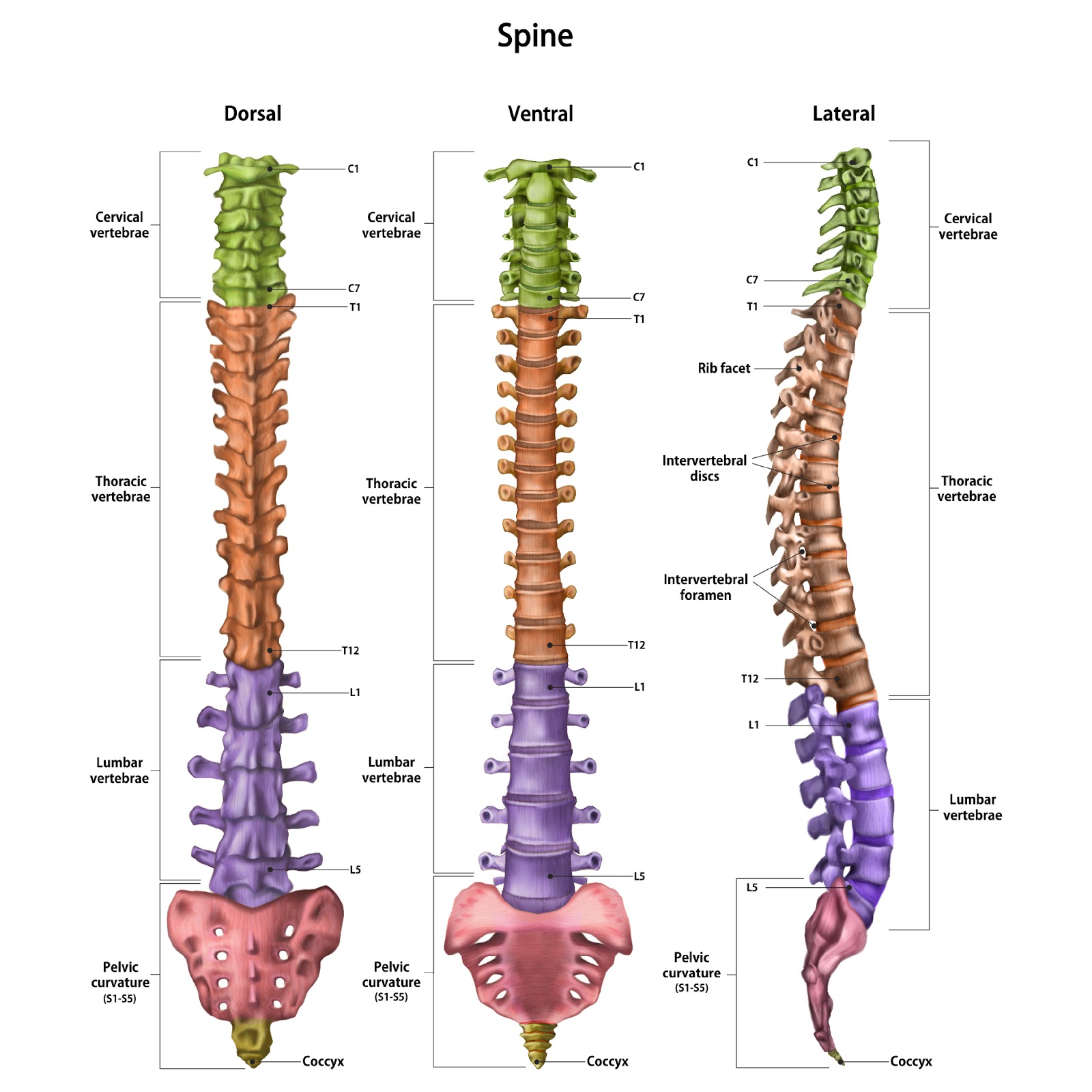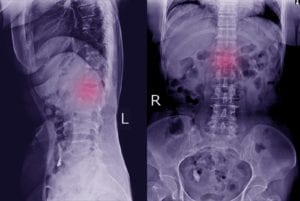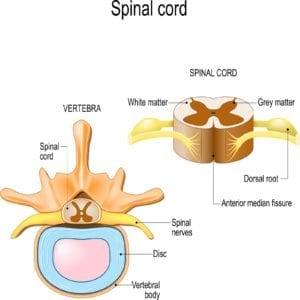Learn about common types of slip and fall back injuries. Find out what your claim might be worth and what you need to win your case.
Along with car accidents, one of the most common types of personal injury claims in the United States are slip and falls.¹ Slip and fall injuries are a type of premises liability claim because they happen when someone is hurt because of a property owner’s negligence.
The violent impact of a slip and fall can cause serious injuries to any part of your back.
Serious back injuries are painful and can destroy your way of life. If you’re the victim of a slip and fall, get the facts about back injuries and learn what you can do to get fair compensation for your losses.
Quick Review of the Anatomy of the Back
 The back is divided into five sections:
The back is divided into five sections:
- Cervical – Neck
- Thoracic – Roughly from shoulders to waist
- Lumbar – Lower back
- Sacrum – Tailbone
- Coccyx – Tip of the tailbone
Muscles and tendons keep your spine aligned. The bones of the spine, called vertebrae, start below the skull and continue down to your tailbone.
The spinal cord runs through a canal in the vertebrae. Bundles of nerves run from the spinal cord to every part of your body. Cushions between your vertebrae, called intervertebral discs, keep the bones from rubbing together and protect the all-important spinal cord and nerves
1. Sprains and Strains
Muscle strain and trauma can lead to soft tissue injuries, even if nothing is broken. Though soft tissue injuries (like sprains or other injuries to tendons and ligaments) may be seen as relatively minor injuries by some, they can be very painful and take time to heal.
A sprain is a partial tear to a ligament and is often caused by a wrench or twist. Sprains often affect the ankles, knees, or wrists. The treatment for a sprain includes rest, ice, compression, and elevation (R.I.C.E.). If the ligament is completely torn, surgical repair may be necessary.
Compensation for most sprains and strains will cost under $5,000. Treatment will consist of a visit to your doctor or urgent care, a couple of x-rays to rule out a fracture, a few days of rest, and a nominal amount of pain and suffering.
2. Herniated or “Slipped” Discs
 A violent impact can rupture an intervertebral disc and cause pain that radiates to other parts of the body from nerve damage. This nerve damage can require complicated, expensive, and risky disc surgery.
A violent impact can rupture an intervertebral disc and cause pain that radiates to other parts of the body from nerve damage. This nerve damage can require complicated, expensive, and risky disc surgery.
Herniated discs can occur anywhere along the spinal column after a slip and fall. Disc damage in the cervical (neck) area can affect nerves leading to the arms and hands. Herniated discs in the lumbar region (lower back) can result in sciatica pain and numbness to the hips, buttocks, and legs.
Total compensation (medical and non-medical) associated with herniated disc treatment can run between $50,000 and $100,000 depending on the scope of your injuries
3. Broken Back Bones
A hard fall can also cause a spinal fracture, meaning broken bones in your spine, more commonly known as a broken back.
The bones that make up your spine are vertebrae. Vertebrae protect the spinal cord, and have hollow openings through which bundles of nerves branch off from the spinal cords to all parts of the body.
Most vertebral fractures, regardless of where they are located, are associated with mild to severe pain (depending on the location of the spinal fracture) which worsens with any type of movement. Any shifting of a broken vertebra can pinch or tear the nerve bundles. In a worst-case scenario, the spinal cord may be damaged.
While most spinal fractures can be treated with medication, braces, and physical therapy, more serious breaks may need surgical repair. It’s imperative for your doctor to stabilize your broken back to prevent crippling nerve damage.
Non-surgical treatment of a broken back can cost up to $15,000. If surgical fusion is required, the medical costs can jump to $150,000, depending on where you are treated.
It can take up to three months for a broken back to heal, keeping the victim out of work. Assuming $10,000 in lost wages, and a multiplier of 3x to account for pain and suffering, the total compensation to the fall victim may range from $100,000 to $640,000.
4. Spinal Cord Injuries
 Most devastating are acute spinal cord injuries that happen as a result of a slip and fall. In the most severe cases, spinal fractures squeeze or tear the spinal cord, causing paralysis below the waist or even the neck. Spinal cord injuries can be catastrophic and life-threatening.
Most devastating are acute spinal cord injuries that happen as a result of a slip and fall. In the most severe cases, spinal fractures squeeze or tear the spinal cord, causing paralysis below the waist or even the neck. Spinal cord injuries can be catastrophic and life-threatening.
If you suffer a slip and fall back injury that leaves you paralyzed or partially disabled, you probably won’t get the full value of your claim without filing a lawsuit.
Lifetime costs of a permanent spinal cord injury can range from $1.7 million to more than $5 million, depending on the victim’s age at injury and the extent of their paralysis.
However, court cases for severe injuries caused by a negligent business can return verdicts in favor of the victim ranging into millions of dollars.
How To Prove Your Injury Claim
Whether or not your claim goes to court, you must gather evidence to support your back injury claim.
The most important parts of injury claim evidence are your medical bills and records. No insurance company will compensate you if you never had treatment for your injury. The more information you have about your condition, the better.
If you aren’t taken directly to the emergency room from the scene of the slip and fall, you must seek prompt medical attention. Tell your medical care providers exactly when, where, and how you were injured. You might be treated by more than one type of doctor, like your family doctor, an orthopedic surgeon, and a neurologist.
You should be compensated for the full cost of all reasonable diagnostic tests and treatments.
Diagnostic studies may include:
- X-rays
- CT Scan
- MRI
- Nerve Conduction Study
If you have a pre-existing back condition or an old injury, you’ll need to show that the slip and fall directly caused your current pain and limitations.
Many times, insurance adjusters or courts will want an expert opinion about your injury. You or your attorney can ask your doctors for a letter or report about your back injury treatment plan and prognosis.
In addition to your medical evidence, gather evidence about how your back injury has affected your quality of life. Pain and suffering is more difficult to quantify, but it’s a critical part of how the injury has affected your life. You deserve to be compensated for all your damages, including pain and suffering.
Finally, get evidence showing how your injury has affected your ability to work. Attendance records, performance reviews, and a lost wage statement from your employer will show the economic consequences of your injury and its intangible effects on your everyday life.
A sudden slip and fall accident can have serious consequences on your life for months or even years. No matter what, your number one priority must be to obtain the medical care you need and mitigate the effect of the injury on your life.
After you have received treatment, you will want to be fully compensated for your losses. Most slip and fall injuries will not be so life-altering as to merit compensation higher than a five or six-figure payout.
Even if you’re inclined to handle your own injury claim, you owe it to yourself to see what a personal injury attorney can do for you. There’s no obligation, and most law firms offer free consultations for injury victims.
How Much is Your Injury Claim Worth?
Find out now with a FREE case review from an attorney…